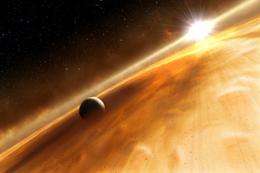The discovery of new Earths is imminent, UD astronomer says

(PhysOrg.com) -- Harry Shipman, Annie Jump Cannon Professor of Physics and Astronomy at the University of Delaware, told the audience for his lecture, “Seeking New Planets,” on Saturday evening, Sept. 26, that one of his purposes was to “stretch your minds.”
And that he did during his high-energy presentation -- all the way to outside our solar system where astronomers have detected 374 other planets so far, and are bound to discover many more, including “new Earths,” he said.
Shipman's presentation kicked off the Harcourt “Ace” Vernon Lecture Series hosted by the Delaware Asteroseismic Research Center (DARC) at UD and sponsored by the Mt. Cuba Astronomical Observatory.
Named in honor of the late Vernon, who was the first chairman of the observatory's board of trustees, the series, which includes two other lectures this autumn, was established to celebrate the 2009 International Year of Astronomy.
How are planets born, and how do scientists detect new planets? Scientists have known for more than a hundred years that there is gas and dust between the stars, Shipman said. Clumps of dust particles can stick together and form into swirling, gaseous circumstellar disks and planets.
While UD faculty and students have discovered disks such as 51 Ophiuchi, the French team of Meyor and Queloz made the first discovery of a planet outside our solar system in 1995, around the star 51 Pegasi.
To find it, the astronomers used a technique based on the Doppler Effect, which hinges on the change in frequency of a wave. Planets reflect light from the star around which they orbit, and each planet exerts a small effect on its parent star. As the planet wobbles in its orbit, it affects the light coming from the star.
Shipman illustrated the Doppler Effect by blowing a train whistle. When a train is coming toward you, the whistle will be at a higher pitch; when the train is moving away from you, the pitch will be lower. The reason it took a long time to detect that first extrasolar planet, Shipman said, is because the planet's Doppler shift is very small.
Another method for detecting planets is to monitor their pulsations, or oscillations, which is what the Whole Earth Telescope, an international collaboration of observatories led by UD and Mt. Cuba Astronomical Observatory, does during their several-week, round-the clock star watches called “international observing runs.”
In 2007, the Whole Earth Telescope team announced the discovery of a planet slightly more massive than Jupiter around V 391 Pegasi, a star late in its life cycle, using this method.
Changes in brightness can also signal the presence of a planet because when a planet gets close to its star, the planet cuts off a little bit of light from the star, but things have to be lined up just right and you have to be observing the star at the right time to notice the periodic dimming.
Eventually, in 5 billion years, the sun in all of its brightness will expand to a red giant star that will destroy the planets that are closest to it.
While that's a long, long way off, “It would be really, really nice to find another Earth,” Shipman said, noting that we are “rapidly racing toward the discovery of new Earths.”
The most Earthlike planet yet is COROT-7b, which was announced in February by the COROT space mission, led by the French Space Agency. It's 500 light years away and too hot to be comfortable, according to Shipman. Some have deemed it the “Lava Planet.”
However, two planets detected beyond our solar system possess gases that represent the essential molecules of life, with only one missing, ammonium, according to Shipman.
Spacecraft and telescopes in space are keeping very close track of the brightness of stars in the search for other planets, and telescopes from ground are also seeking to find planets around other stars.
NASA launched the Kepler spacecraft in March 2009 to survey our region of the Milky Way galaxy for Earth-size and smaller planets, and the large, infrared James Webb Space Telescope, with a mirror over 21 feet in diameter, will provide an even deeper look into the cosmos.
“It's particularly fun to be an astronomer right now because until a few years ago, other planets beyond our solar system didn't exist,” Shipman noted. “This is one of the most exciting quests since I've gotten involved in astronomy.”
Provided by University of Delaware (news : web)




















